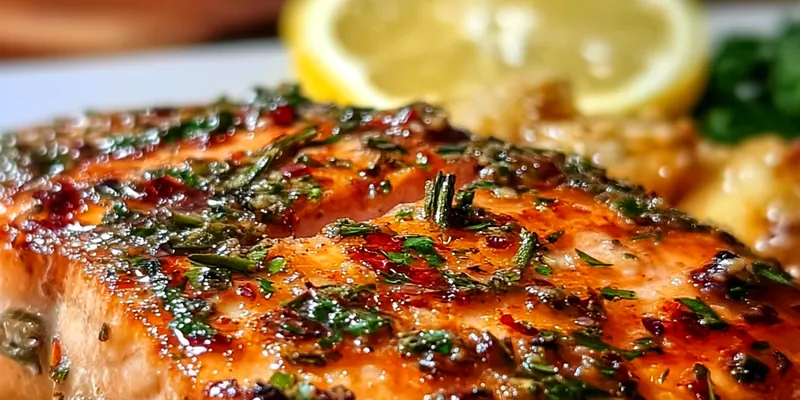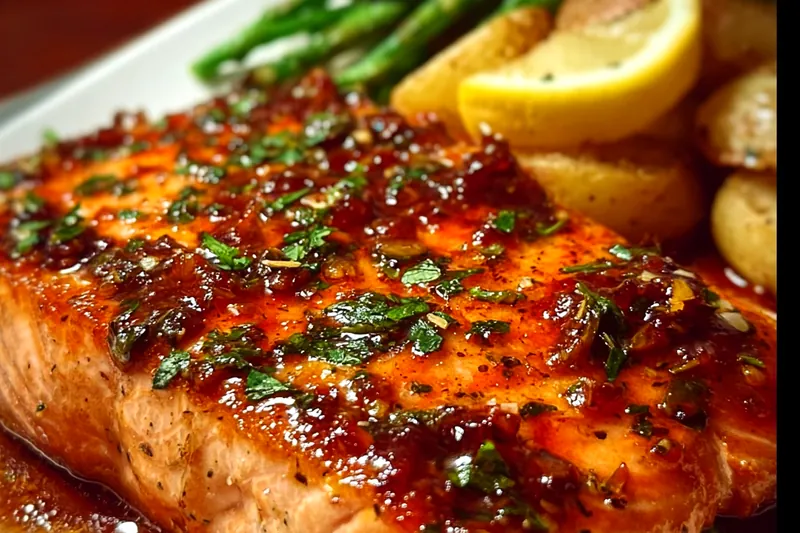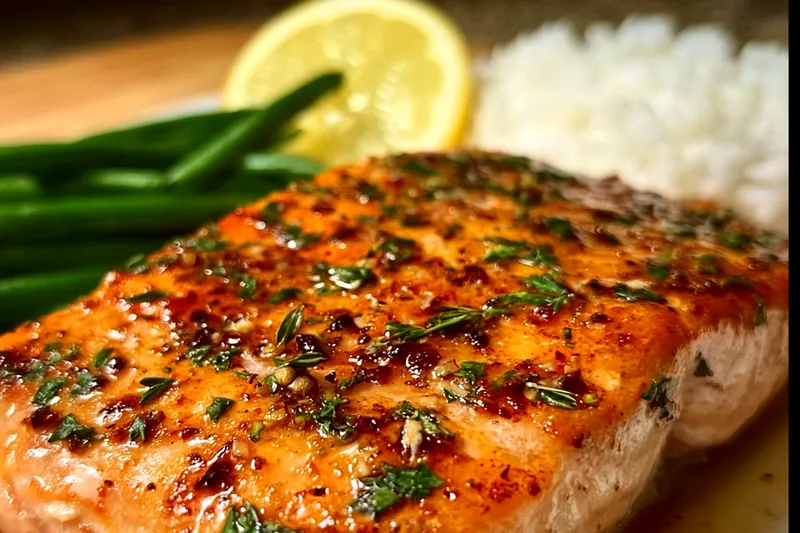Texas Roadhouse Style Baked Salmon
Tender, flaky baked salmon with Texas Roadhouse's signature seasoning blend and buttery finish. A restaurant-quality dish that's easy to make at home.

The Secret to Restaurant-Quality Salmon
The magic of Texas Roadhouse salmon lies in their carefully balanced seasoning blend that combines savory spices with a hint of sweetness from brown sugar. This creates a beautiful caramelized crust while keeping the interior moist and flaky.
The generous butter application both before and after cooking is crucial for achieving that signature restaurant flavor and texture. The butter not only adds richness but also helps the seasoning adhere and creates the golden-brown finish that makes this dish so appealing.
💡 Professional Tip
Pat the salmon completely dry before seasoning to ensure the spice blend adheres properly and creates the best crust during baking.
Frequently Asked Questions
Atlantic or King salmon fillets work best due to their higher fat content and rich flavor. Choose fillets that are 1-1.5 inches thick for even cooking.
Yes, but thaw completely first and pat very dry. Frozen salmon may release more moisture during cooking, so increase baking time by 2-3 minutes if needed.
The salmon should flake easily with a fork and reach an internal temperature of 145°F (63°C). It should be opaque throughout but still moist.
Absolutely! The seasoning blend can be made up to 1 month ahead and stored in an airtight container. It's great on chicken and pork too.
The core flavors come from garlic powder, onion powder, and paprika. You can substitute Italian seasoning for the oregano and thyme if needed.
Yes! Grill over medium-high heat for 4-5 minutes per side, basting with butter throughout. Use a fish basket to prevent sticking.
Don't overcook - remove when it just flakes easily. The butter and proper temperature (425°F) help retain moisture throughout cooking.
Texas Roadhouse style green beans, mashed sweet potatoes, or seasoned rice pilaf complement the flavors perfectly. A simple salad works well too.
Recipe Troubleshooting Guide
Dry Salmon
Problem: Salmon turns out dry and overcooked
Solution: Reduce cooking time, check temperature with thermometer, and don't cook beyond 145°F internal temperature. Use more butter during cooking.
Seasoning Won't Stick
Problem: Spice blend falls off during cooking
Solution: Pat salmon completely dry before seasoning, brush with oil first, then press seasoning firmly into flesh. Don't flip during baking.
Uneven Cooking
Problem: Some parts cook faster than others
Prevention: Choose fillets of uniform thickness, or fold thinner tail portions under. Rotate pan halfway through baking for even heat.
Not Flavorful Enough
Problem: Salmon lacks the bold restaurant flavor
Recovery: Use more seasoning blend, ensure it covers all surfaces, and don't skip the butter finish. Let salmon come to room temperature before cooking.
Burnt Exterior
Problem: Seasoning burns before salmon is cooked through
Prevention: Lower oven temperature to 400°F and cook longer, or tent with foil if browning too quickly. Don't use too much brown sugar.
Flavor Balance Issues
Too Sweet: Reduce brown sugar or add more black pepper and salt
Too Salty: Add more lemon juice or serve with a dollop of sour cream
Bland: Increase garlic powder and paprika, or add more butter finish

Selecting the Perfect Salmon
Choose fresh, high-quality salmon fillets with bright color and firm texture. The fillets should have a fresh, ocean-like smell without any fishy odors. Skin-on or skinless both work well, though skin-on helps retain moisture during cooking.
Look for fillets that are similar in thickness for even cooking. If you can only find varying sizes, fold the thinner tail portions under to create more uniform thickness, ensuring all pieces finish cooking at the same time.
Essential Ingredient Notes
- Salmon Quality: Choose center-cut fillets when possible for the most even thickness. Wild-caught salmon has firmer texture, while farm-raised is more consistently fatty.
- Spice Freshness: Use fresh spices for the best flavor. Spices older than 2 years should be replaced as they lose potency and can taste stale.
- Butter Choice: Use high-quality unsalted butter so you can control the salt level. European-style butter with higher fat content provides even richer flavor.

Mastering the Cooking Technique
The key to perfect baked salmon is high heat for a relatively short time, which creates a beautiful crust while keeping the interior moist. The 425°F temperature is ideal for achieving the restaurant-style results with proper browning.
Timing is crucial - start checking for doneness at 15 minutes, as overcooking is the most common mistake. The salmon will continue cooking slightly after removal from the oven, so err on the side of slightly underdone rather than overcooked.
The Perfect Finish
The final butter brush after baking adds that signature restaurant gloss and richness that makes this dish special. Don't skip this step!
Texas Roadhouse Style Baked Salmon
📋 Ingredients
For the Salmon
- 2 tsp garlic powderEssential savory base flavor
- 2 tsp onion powderAdds depth and sweetness
- 1 tsp paprikaProvides color and mild heat
- 1 tsp dried oreganoAdds herbal complexity
- 1/2 tsp brown sugarCreates caramelization
- 30ml fresh parsley, choppedFresh finishing garnish
For the Signature Seasoning
- 4 salmon fillets (6 oz each)Choose center-cut for even thickness
- 60g unsalted butter, meltedSignature rich, buttery flavor
- 15ml olive oilHelps seasoning adhere
- 1 tsp dried thymeEarthy herb component
- 1/2 tsp cayenne pepperSubtle heat element
- 1 tsp saltEnhances all flavors
- 15ml lemon juiceBrightens and balances richness
Instructions
Prepare Seasoning Blend
Preheat oven to 425°F (220°C). In a small bowl, combine garlic powder, onion powder, paprika, oregano, thyme, cayenne pepper, black pepper, salt, and brown sugar. Mix well to create the signature seasoning blend.
Prepare Salmon
Pat salmon fillets dry with paper towels and place on a parchment-lined baking sheet. Brush both sides with olive oil, then generously coat with the seasoning blend, pressing gently to adhere.
Add Butter and Lemon
Drizzle melted butter over each seasoned salmon fillet, then add a few drops of lemon juice to each piece. This creates the signature buttery flavor that makes the dish special.
Bake the Salmon
Bake for 15-18 minutes, or until salmon flakes easily with a fork and reaches an internal temperature of 145°F (63°C). Cooking time may vary based on thickness of fillets.
Finish and Serve
Remove from oven and immediately brush with additional melted butter. Garnish with fresh chopped parsley and serve with lemon wedges. Serve immediately while hot.
Recipe Notes & Tips
Storage
Leftover salmon keeps in the refrigerator for up to 3 days. Reheat gently in a 300°F oven or enjoy cold in salads. The seasoning blend can be stored for up to 1 month.
Serving Suggestions
Serve with roasted vegetables, rice pilaf, or mashed potatoes. The rich, savory salmon pairs beautifully with light, fresh sides like steamed broccoli or a crisp salad.
Variations
Try this seasoning blend on chicken, pork chops, or shrimp. For a spicier version, increase the cayenne pepper or add a pinch of chipotle powder to the blend.
